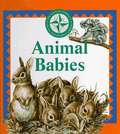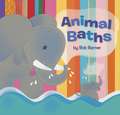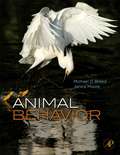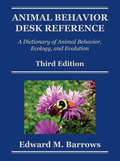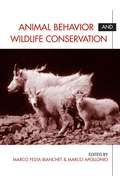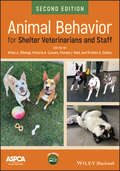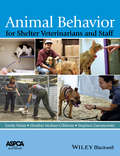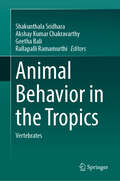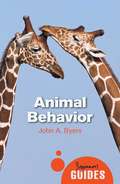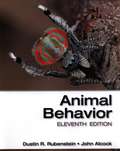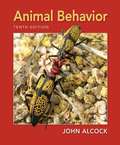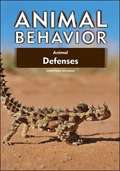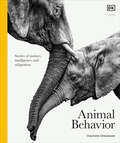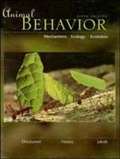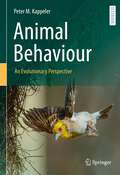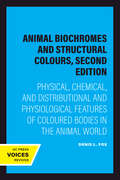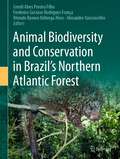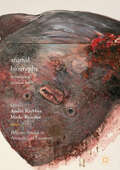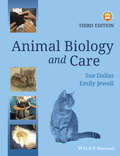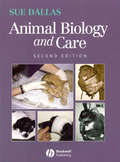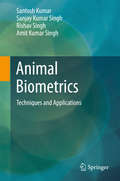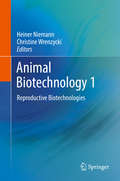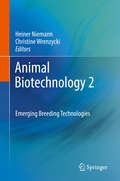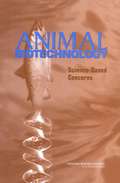- Table View
- List View
Animal Babies (Nature Company Discoveries Libraries)
by Claire Craig Young StaffExplores the colorful world of animal babies, introducing children to young animals who are hatched from eggs, carried in pouches, born singly, or born in groups, in an interactive guide complete with fold-out panels and curiosity boxes.
Animal Baths
by Bob BarnerDiscover how all kinds of animals bathe in this playful exploration of bath time in the animal kingdom! Learn how tiny shrimp aid eels in keeping their teeth squeaky clean, and how schools of fish help sharks stay spic and span. Young readers will recognize their own bath time habits, and will love splashing and playing along in their own imaginative way. Simple rhyming text and vibrant, colorful collages by award-winning author and artist Bob Barner make this book ideal for the youngest readers and bathers!
Animal Behavior
by Michael Breed Janice MooreAnimal Behavior covers the broad sweep of animal behavior from its neurological underpinnings to the importance of behavior in conservation. The authors, Michael D. Breed and Janice Moore, bring almost 60 years of combined experience as university professors to this textbook, much of that teaching animal behavior. An entire chapter is devoted to the vibrant new field of behavior and conservation, including topics such as social behavior and the relationship between parasites, pathogens, and behavior. Thoughtful coverage has also been given to foraging behavior, mating and parenting behavior, anti-predator behavior and learning. This text addresses the physiological foundations of behavior in a way that is both accessible and inviting. Each chapter begins with learning objectives and concludes with thought-provoking questions. Additionally, special terms and definitions are highlighted throughout.
Animal Behavior Desk Reference: A Dictionary of Animal Behavior, Ecology, and Evolution, Third Edition
by Edward M. Barrows"Words are our tools, and, as a minimum, we should use clean tools. We should know what we mean and what we do not, and we must forearm ourselves against the traps that language sets us." -- The Need for Precise Terminology, Austin (1957, 7-8) It follows that, for effective and efficient communication, people should have, or at least understand, th
Animal Behavior and Wildlife Conservation
by Marco Apollonio Marco Festa-BianchetEfforts to conserve wildlife populations and preserve biological diversity are often hampered by an inadequate understanding of animal behavior. How do animals react to gaps in forested lands, or to sport hunters? Do individual differences--in age, sex, size, past experience--affect how an animal reacts to a given situation? Differences in individual behavior may determine the success or failure of a conservation initiative, yet they are rarely considered when strategies and policies are developed. Animal Behavior and Wildlife Conservation explores how knowledge of animal behavior may help increase the effectiveness of conservation programs. The book brings together conservation biologists, wildlife managers, and academics from around the world to examine the importance of general principles, the role played by specific characteristics of different species, and the importance of considering the behavior of individuals and the strategies they adopt to maximize fitness.Each chapter begins by looking at the theoretical foundations of a topic, and follows with an exploration of its practical implications. A concluding chapter considers possible future contributions of research in animal behavior to wildlife conservation.
Animal Behavior for Shelter Veterinarians and Staff
by Pamela J. Reid Brian A. DiGangi Victoria A. Cussen Kristen A. CollinsAnimal Behavior for Shelter Veterinarians and Staff A comprehensive resource to understand the behavioral considerations for intake, management, and rehoming of dogs and cats Animal Behavior for Shelter Veterinarians and Staff provides readers with comprehensive information addressing the behavior of both animals and humans associated with the intake, management, and rehoming of dogs and cats. To aid in practical application, the book covers specific behavior considerations in both dogs and cats. Topics are separated by animal to allow for easy accessibility by professionals who are actively working in the field. Sample topics covered within the book include: The behavior issues that are a common cause of pet relinquishment Behavioral assessment, behavior modification, the integration of behavioral well-being into sheltering Welfare assessment, psychopharmacology, safety net programs, and caring for animals during long-term legal holds Equine care and caring for small mammals Animal Behavior for Shelter Veterinarians and Staff is a must-have reference for evidence-based practical tips, techniques, and protocols for everyday use in animal shelters by shelter volunteers and staff, as well as professional trainers, behaviorists, and veterinarians working with shelters.
Animal Behavior for Shelter Veterinarians and Staff
by Stephen Zawistowski Emily Weiss Heather Mohan-GibbonsAnimal Behavior for Shelter Veterinarians and Staff presents and evaluates the available research and programs that address both animal and human behaviors associated with the intake, management and rehoming of dog and cats. Introductions to dog and cat behavior relevant to any animal professional Reviews behavioral reasons for the relinquishment of dogs and cats Describes intake and assessment protocol, shelter design, training and enrichment programs that reduce stress and enhance behavioral well-being Concepts to improve the adoption process and support the human-animal bond post-adoption
Animal Behavior in the Tropics: Vertebrates
by Akshay Kumar Chakravarthy Shakunthala Sridhara Geetha Bali Rallapalli RamamurthiThis book discusses trends in animal behavior focusing specifically on vertebrates from the tropical region. It includes topics on a wide range of disciplines such as electrophysiology, molecular biology, reproductive physiology, foraging and feeding behavior, chemical ethology and ecology, in-situ and ex-situ conservation, circadian rhythms, climate change and several other related topics that are of high interest and utility. Tropical countries have a unique and diversified fauna across their different biogeographical habitats. This book covers numerous species of vertebrates from the tropical region and also discusses several case studies to provide detailed information about the recent trends in the animal behavior pattern. This book is useful for academicians, researchers, ethologists, wildlife specialists and practitioners. This book is also an interesting read for scholars, professors and policy makers involved in the field of zoology, naturalists and wildlife enthusiasts.
Animal Behavior: A Beginner's Guide (Beginner's Guides)
by John ByersWhy do birds have regional accents? Can horses learn math? What do animals without eyes see? Questions such as these have fascinated scientists and animal lovers alike long before ethology - the study of animal behavior - became recognized as a science in the 1970s. Now, as issues of conservation and welfare dominate the field, an understanding of how and why animals act the way they do has become even more critical.Communicating the passion of the scientists who have driven the discipline, John Byers draws together evolutionary theory, ecology, population biology, genetics, physiology, and anatomy to demonstrate the diversity involved when studying animals. By explaining the mechanisms and motivations behind a range of animal movements he illuminates key issues about our own behavior while equipping readers with the core knowledge and skills to further their own studies.
Animal Behavior: An Evolutionary Approach
by John Alcock Dustin RubenstienA comparative and integrative overview of how and why animals as diverse as insects and humans behave the way that they do, linking behaviors to the brain, genes, and hormones, as well as to the surrounding ecological and social environments.
Animal Behavior: An Evolutionary Approach
by John AlcockThe tenth edition features a major reorganisation, focusing first on the evolutionary basis of behavior followed by the underlying proximate mechanisms. Enduring features of previous editions also remain; the clear engaging writing style, the beautifully illustrated text with many new photographs and numerous references to new scientific articles.
Animal Behavior: Animal Defenses
by Christina WilsdonThis book presents the wide variety of physical and behavioral adaptations used by animals to defend themselves against predators. From insects that look like leaves, to fish that fly and toads with poisonous skins, the methods of defense seem limitless, with new ones continuing to be discovered.
Animal Behavior: Concepts, Methods, and Applications, Third Edition
by Shawn E. Nordell Thomas J. ValoneEmphasizes Concepts. Animal Behavior: Concepts, Methods, and Applications, Third Edition, uses broad organizing concepts to provide a framework for understanding the science of animal behavior. In an engaging, question-driven style, Shawn E. Nordell and Thomas J. Valone offer readers a clear learning progression for understanding and evaluating empirical research examples. Focuses On Methodology and The Process of Science. Featured studies illustrate each concept and emphasize the experimental designs and the hypothesis testing methods scientists use to address research questions. Highlights Real-World Applications. Concepts are related to real life to help students understand the broader significance of animal behavior research, including applications to human behavior and conservation.
Animal Behavior: Life in the Wild (DK Definitive Visual Encyclopedias)
by DKA thrilling face-to-face encounter with animals in their own environment—their elaborate displays, intimate lives, and extraordinary behavior. Did you know that elephants give each other names, orangutans self-medicate, and rats giggle? Animal Behavior is full of hundreds of stories that shed light on how animals navigate life in the wild. Packed with vivid wildlife photography and action sequences, every aspect of animal life and behavior is explored and explained – from courtship rituals and birth to hunting and death. An initial overview of animal anatomy and physiology reveals the science and biomechanics that underpin animal behavior, while later chapters thematically break down the intricacies of animal feeding, development, communication, intelligence, learning, and other behavioral characteristics. Learn about play through river otters, see socialization among parrots at the riverbank, and catch prey with a fishing spider. Feature panels throughout the book explore the biology behind these traits, introduce case studies from the field, and highlight critical conservation issues facing these animals. Animal Behavior has been created in collaboration with internationally renowned zoologist and TV presenter Charlotte Uhlenbroek and a team of wildlife experts to ensure up-to-date and accurate information.
Animal Behavior: Mechanisms, Ecology, Evolution
by Lee C. Drickamer Stephen H. Vessey Elizabeth JakobAnimal behavior is a broad discipline diverse perspectives, including anthropology, comparative psychology, ecology, ethology, physiology, and zoology.
Animal Behaviour: An Evolutionary Perspective
by Peter M. KappelerThis textbook presents all basic principles of animal behaviour in a clear and concise manner and illustrates them with up-to-date examples. Emphasis is placed on behavioural biology as an integrative discipline of organismic biology, focusing on the adaptive value of behaviours that facilitate resource access, predator avoidance and reproductive success and underlie parental care, all within a comprehensive presentation of social complexity. This new textbook provides a rich resource for students (and teachers) from a wide range of life science disciplines.
Animal Biochromes and Structural Colours, Second Edition: Physical, Chemical, and Distributional and Physiological Features of Coloured Bodies in the Animal World
by Denis L. FoxThis title is part of UC Press's Voices Revived program, which commemorates University of California Press’s mission to seek out and cultivate the brightest minds and give them voice, reach, and impact. Drawing on a backlist dating to 1893, Voices Revived makes high-quality, peer-reviewed scholarship accessible once again using print-on-demand technology. This title was originally published in 1976.This title is part of UC Press's Voices Revived program, which commemorates University of California Press’s mission to seek out and cultivate the brightest minds and give them voice, reach, and impact. Drawing on a backlist dating to 1893, Voices Revived</DIV
Animal Biodiversity and Conservation in Brazil's Northern Atlantic Forest
by Rômulo Romeu Nóbrega Alves Gentil Alves Pereira Filho Frederico Gustavo Rodrigues França Alexandre VasconcellosThis book describes the fauna of the Pernambuco Endemism Center in Brazil's Northern Atlantic Forest, an understudied global biodiversity hotspot. Through fifteen curated chapters, it provides the latest information about the fauna of the northern portion of the Atlantic Forest, gathering important information about the faunal composition of the region for the first time. The chapters address animal biodiversity including terrestrial and aquatic vertebrates (fish, amphibians, reptiles, birds, and mammals) and invertebrates (ants, butterflies, dung beetles, hervestmen, spiders, and termites). All chapters provide species lists, taxonomic aspects and richness analysis. Conservation of specific animal groups is also discussed. Finally, the book discusses human impacts on the forest and its biodiversity, emphasizing the need for conservation of this highly impacted ecosystem.
Animal Biography: Re-framing Animal Lives (Palgrave Studies in Animals and Literature)
by André Krebber Mieke RoscherWhile historiography is dominated by attempts that try to standardize and de-individualize the behavior of animals, history proves to be littered with records of the exceptional lives of unusual animals. This book introduces animal biography as an approach to the re-framing of animals as both objects of knowledge as well as subjects of individual lives. Taking an interdisciplinary perspective and bringing together scholars from, among others, literary, historical and cultural studies, the texts collected in this volume seek to refine animal biography as a research method and framework to studying, capturing, representing and acknowledging animal others as individuals. From Heini Hediger’s biting monitor, Hachikō and Murr to celluloid ape Caesar and the mourning of Topsy’s gruesome death, the authors discuss how animal biographies are discovered and explored through connections with humans that can be traced in archives, ethological fieldwork and novels, and probe the means of constructing animal biographies from taxidermy to film, literature and social media. Thus, they invite deeper conversations with socio-political and cultural contexts that allow animal biographies to provide narratives that reach beyond individual life stories, while experimenting with particular forms of animal biographies that might trigger animal activism and concerns for animal well-being, spur historical interest and enrich the literary imagination.
Animal Biology and Care
by Sue Dallas Emily JewellThe perfect study companion, Animal Biology and Care, 3rd Edition is specifically designed for students on animal care, animal nursing assistant and veterinary care assistant courses. This edition is fully updated with new course content, a refreshed design and colour illustrations throughout. Basic biological theory is introduced with diagrams for visual learners while photographs demonstrate the common practical procedures carried out by animal care assistants. Key features include: New content on exotic species, recognising the increasing number of these animals kept as pets. Extensive coverage of the Animal Welfare Act 2006 and recent advances in animal welfare. Written in line with course curricula, chapter summaries help you to remember key points and learning objectives. A companion website has interactive MCQs to help you test your knowledge. Divided into three main sections covering animal science and genetics, health and husbandry and nursing procedures, this book will help lay the foundations for a successful career in animal care and management!
Animal Biology and Care
by Sue DallasFollowing the success of the first edition, this new edition has been expanded to include more information on small mammals, birds and fish. Intended as a foundation text for those on animal care, nurse auxiliary and veterinary care assistant courses, it introduces essential theoretical background information and clearly outlines the practical skills necessary when embarking on the care of any animal. Designed specifically to meet the requirements of animal care, pre-veterinary nursing auxiliary and care students; Provides basic training in animal biology and care, with particular attention given to those subjects that students find difficult to understand, such as anatomy and physiology; New chapter additions on fish and birds. Clearly and simply laid out, with over 150 illustrations, Animal Biology and Care 2e will be invaluable to all those training or working in animal care.
Animal Biometrics: Techniques And Applications
by Santosh Kumar Amit Kumar Singh Sanjay Kumar Singh Rishav SinghThis book presents state-of-the-art methodologies and a comprehensive introduction to the recognition and representation of species and individual animals based on their physiological and phenotypic appearances, biometric characteristics, and morphological image patterns. It provides in-depth coverage of this emerging area, with an emphasis on the design and analysis techniques used in visual animal biometrics-based recognition systems. <P><P>The book offers a comprehensive introduction to visual animal biometrics, addressing a range of recent advances and practices like sensing, feature extraction, feature selection and representation, matching, indexing of feature sets, and animal biometrics-based multimodal systems. It provides authoritative information on all the major concepts, as well as highly specific topics, e.g. the identification of cattle based on their muzzle point image pattern and face images to prevent false insurance claims, or the monitoring and registration of animals based on their biometric features. <P>As such, the book provides a sound platform for understanding the Visual Animal Biometrics paradigm, a vital catalyst for researchers in the field, and a valuable guide for professionals. In addition, it can help both private and public organizations adapt and enhance their classical animal recognition systems.
Animal Biotechnology 1: Reproductive Biotechnologies
by Heiner Niemann Christine WrenzyckiThis two-volume textbook provides a comprehensive overview on the broad field of Animal Biotechnology with a special focus on livestock reproduction and breeding. The reader will be introduced to a variety of state-of-the-art technologies and emerging genetic tools and their applications in animal production. Also, ethics and legal aspects of animal biotechnology will be discussed and new trends and developments in the field will be critically assessed. The two-volume work is a must-have for graduate students, advanced undergraduates and researchers in the field of veterinary medicine, genetics and animal biotechnology.This first volume mainly focuses on artificial insemination, embryo transfer technologies in diverse animal species and cryopreservation of oocytes and embryos.
Animal Biotechnology 2: Emerging Breeding Technologies
by Heiner Niemann Christine WrenzyckiThis two-volume textbook provides a comprehensive overview on the broad field of Animal Biotechnology with a special focus on livestock reproduction and breeding. The reader will be introduced to a variety of state-of-the-art technologies and emerging genetic tools and their applications in animal production. Also, ethics and legal aspects of animal biotechnology will be discussed and new trends and developments in the field will be critically assessed. The two-volume work is a must-have for graduate students, advanced undergraduates and researchers in the field of veterinary medicine, genetics and animal biotechnology.This second volume is dedicated to genetic tools in animal biotechnology such as somatic cloning, transgenic technologies and the application of stem cells in livestock breeding. Also, ethics and legal aspects are discussed.
Animal Biotechnology: Science-based Concerns
by National Research CouncilGenetic-based animal biotechnology has produced new food and pharmaceutical products and promises many more advances to benefit humankind. These exciting prospects are accompanied by considerable unease, however, about matters such as safety and ethics. This book identifies science-based and policy-related concerns about animal biotechnology—key issues that must be resolved before the new breakthroughs can reach their potential.The book includes a short history of the field and provides understandable definitions of terms like cloning. Looking at technologies on the near horizon, the authors discuss what we know and what we fear about their effects—the inadvertent release of dangerous microorganisms, the safety of products derived from biotechnology, the impact of genetically engineered animals on their environment. In addition to these concerns, the book explores animal welfare concerns, and our societal and institutional capacity to manage and regulate the technology and its products. This accessible volume will be important to everyone interested in the implications of the use of animal biotechnology.
